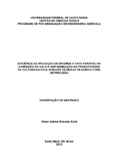| dc.creator | Santi, Olavo Gabriel Rossato | |
| dc.date.accessioned | 2014-09-16 | |
| dc.date.available | 2014-09-16 | |
| dc.date.issued | 2013-08-30 | |
| dc.identifier.citation | SANTI, Olavo Gabriel Rossato. Efficiency of the variable fertilizers rate application in the soil correction and yeld standardisation of soybean crop through precision farming maps. 2013. 78 f. Dissertação (Mestrado em Engenharia Agrícola) - Universidade Federal de Santa Maria, Santa Maria, 2013. | por |
| dc.identifier.uri | http://repositorio.ufsm.br/handle/1/7573 | |
| dc.description.abstract | The use of tools and techniques of precision agriculture by farmers is not a new in
the field, because their uses are increasing year after year. Among them have been
highlighted soil samples using the handheld GPS and yield maps as tools for
identifying soil variability and production. In order to verify the efficiency of the
variable fertilizers rates in improving of the soil fertility and productivity reflexes. The
research was conducted in the Coxilha city, in the Rio Grande do Sul State, in a crop
with no tillage system consolidated for over 15 years. The soil is a dystrophic Red
Hapludox. The climate is humid subtropical Cfa, in according to the Köppen
classification. Initially, in 2011, were vectorized with GPS navigation, 51.05 hectares
and generated 35 compounded samples of soil, on a sampling grid of 1.5 hectares,
to evaluate the chemical variability of the soil. Was used the software Campeiro CR 7
to generate the maps of chemical attributes. The same procedure was repeated in
2012 to verify the effects of soil corrections. The yield maps were obtained in
soybean seasons of 2005, 2008, 2011, 2012 and 2013, and were generated with the
help of the Ag Leader SMS software. After, correlations were made between fertility
and productivity for the years 2011, 2012 and 2013. The results showed that the use
of the soil sampling loop was effective for identify the variability in the soil fertility
attributes and the effects of interventions in the variable rate. To the yield maps, it
was verified no decreases in the variability of harvest after the nutrients variable rate
corrections. It was possible to define regions with consistent productivity using the
superposition of several yeld maps technique. The nutrient that most evolved, after
the soil corrections, was the phosphorus and the same had the highest correlation
with yield for the years 2012 and 2013. | eng |
| dc.description.sponsorship | Fundação de Amparo a Pesquisa no Estado do Rio Grande do Sul | |
| dc.format | application/pdf | por |
| dc.language | por | por |
| dc.publisher | Universidade Federal de Santa Maria | por |
| dc.rights | Acesso Aberto | por |
| dc.subject | Correção de solo | por |
| dc.subject | Manejo localizado | por |
| dc.subject | Taxa variável | por |
| dc.subject | Soil correction | eng |
| dc.subject | Localized management | eng |
| dc.subject | Variable rate | eng |
| dc.title | Eficiência da aplicação de insumos a taxa variável na correção do solo e uniformização da produtividade da cultura da soja através de mapas de agricultura de precisão | por |
| dc.title.alternative | Efficiency of the variable fertilizers rate application in the soil correction and yeld standardisation of soybean crop through precision farming maps | eng |
| dc.type | Dissertação | por |
| dc.description.resumo | A utilização da ferramenta e técnicas de agricultura de precisão pelos agricultores
não é mais novidade no campo, pois seu emprego aumenta a cada ano. Entre elas
vêm se destacando a amostragem de solo com o auxilio do GPS, e mapas de
produtividade como ferramentas para identificar variabilidade de solo e produção.
Com o objetivo de verificar a eficiência da utilização da taxa variável de insumos na
melhoria da fertilidade do solo e reflexos em produtividade. A pesquisa foi
desenvolvida no município de Coxilha, Rio Grande do Sul, em uma lavoura com
plantio direto consolidado há mais de 15 anos. O solo é um Latossolo vermelho
distrófico típico. O clima é subtropical úmido Cfa, segundo a classificação de
Köppen. Inicialmente, no ano de 2011, foram vetorizados, com GPS de navegação,
51,05 hectares e geradas 35 amostras compostas de solo, em uma malha amostral
de 1,5 hectares, para avaliar a variabilidade química do solo. Foi utilizando o
software CR Campeiro 7 para gerar os mapas de atributos químicos. Sendo repetido
o mesmo procedimento em 2012 para verificar os efeitos das correções de solo. Os
mapas de produtividade foram obtidos nas safras de soja de 2005, 2008, 2011, 2012
e 2013 e foram gerados com o auxilio do software SMS Ag Leader. Após foram
feitas as correlações entre fertilidade e produtividade para os anos de 2011, 2012 e
2013. Os resultados mostraram que a utilização de amostragem de solo em malha
foi eficiente para identificar a variabilidade existente nos atributos de fertilidade do
solo bem como os efeitos das intervenções em taxa variável. Para os mapas de
produtividade, não se verificou diminuição da variabilidade de colheita após as
correções em taxa variável de nutrientes. Foi possível definir regiões com
produtividade consistente com o uso da técnica de sobreposição de vários mapas de
produtividade. O nutriente que mais evoluiu, após as correções de solo, foi o fósforo
e o mesmo teve a maior correlação com a produtividade para os anos de 2012 e
2013. | por |
| dc.contributor.advisor1 | Durigon, Reges | |
| dc.contributor.advisor1Lattes | http://lattes.cnpq.br/4039409915626426 | por |
| dc.contributor.referee1 | Russini, Alexandre | |
| dc.contributor.referee1Lattes | http://lattes.cnpq.br/4912380699178131 | por |
| dc.contributor.referee2 | Werner, Valmir | |
| dc.contributor.referee2Lattes | http://lattes.cnpq.br/6381020055451118 | por |
| dc.creator.Lattes | http://lattes.cnpq.br/8256325618900492 | por |
| dc.publisher.country | BR | por |
| dc.publisher.department | Engenharia Agrícola | por |
| dc.publisher.initials | UFSM | por |
| dc.publisher.program | Programa de Pós-Graduação em Engenharia Agrícola | por |
| dc.subject.cnpq | CNPQ::CIENCIAS AGRARIAS::ENGENHARIA AGRICOLA | por |


